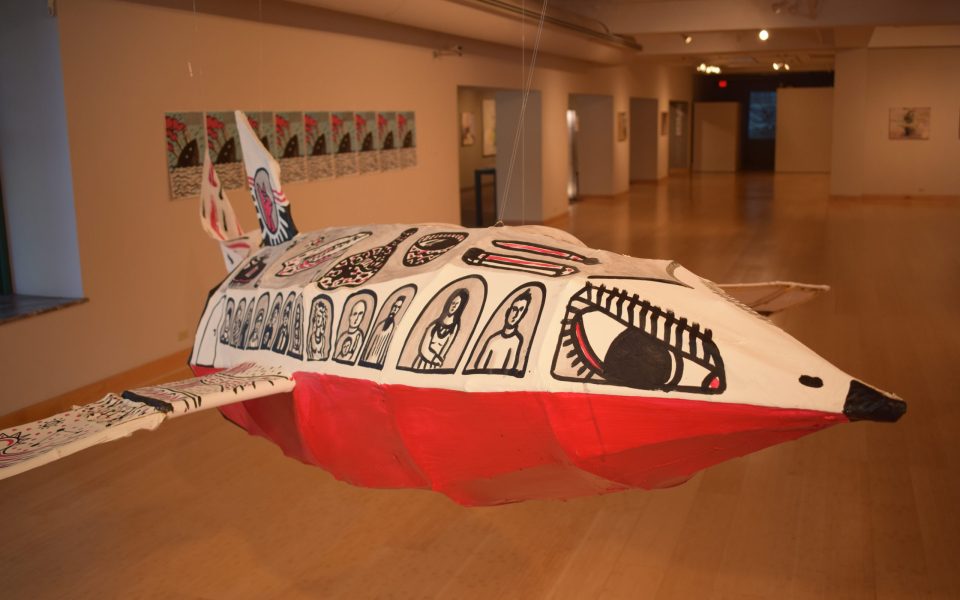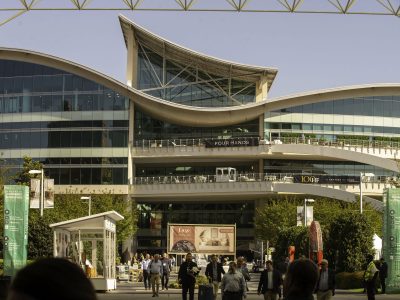Visitors might encounter the strumming of a guitar upon entering artist Renzo Ortega’s home in Carrboro, NC but they won’t see many art supplies; Ortega prefers solitude and silence, painting in a shared studio on a set schedule: Tuesday and Thursday nights and all day Saturday, like clockwork.
In contrast to Ortega’s regimented work routine, his art is far from quiet or predictable. Of late, his audacious palette consists almost solely of black and brilliant red acrylic on canvas, or on recycled cardboard boxes arranged into pillars for an assemblage installation piece at the Greenhill Center in Greensboro entitled Moving In, Moving Out. His brushstrokes lay thick and fast.
Ortega grew up in Peru, attending la Escuela Nacional Superior Autónoma de Bellas Artes in Lima before emigrating to the United States 17 years ago, at age 26, to study mixed media and composition through the Art Students League of New York. He eventually earned his masters of fine arts from Hunter College in 2014. Last year, after 16 years in New York, he relocated with his infant son to Carrboro in his girlfriend’s home state of North Carolina.
“I am a Peruvian immigrant but all my professional career has been in the United States so it’s not that I’m doing Peruvian art; my art belongs to the country, to the issues and the history of this country, too,” Ortega said during a phone interview. “No matter what, it is Peruvian though because I’m the person it is coming from. But my art is about our contemporary history as people who live in the United States.”
Ortega’s multimedia work is currently displayed alongside Greensboro-based artist and Guilford College professor Antoine Williams’ acrylic and wheat-paste paintings; the two are sharing the gallery’s principal space for a concurrent exhibit, Two Artists, One Space.
“[Williams] is from North Carolina and he has experienced what it is to be an African American in this current environment,” Ortega said. “He’s also an academic, so his range of vision is huge. To have our histories that are contemporary and part of this country’s history in that space is really great; to have these voices present is important. We are sharing the space, walking together in the same path.”
Both artists embed ties from past and present in their work. Last year, when Ortega realized bamboo is common in many nearby public spaces, he decided to incorporate the Peruvian tradition of bamboo-building. It’s a practical solution and one that he said allows him to keep a folk tradition alive in his work. A quick peek under his soaring installation at Greenhill reveals delicate yet sturdy craftwork. [pullquote]View Ortega’s work at GreenHill Center in the Greensboro Cultural Center at 200 N. Davie St. (GSO) through Nov. 5 and learn more about his upcoming artist talk on Oct. 25 at 6 p.m. at greenhillnc.org.[/pullquote]
Around two dozen diverse travelers — small children, punks, religious figures and all — peer outward from painted windows on the more than five-foot long, suspended airplane with a bright red belly. A soaring bird appears in the middle of the plane’s left wing beyond four goldfish and before an array of feathers extending toward the wing’s tip. The right wing also features the leaf-like feathers but the innermost two-thirds of the wing hosts a more eclectic mix of geometric shapes, a shooting star and dizzying squiggles and polka dots. Seashells, an envelope, soccer cleats and reed pipes embellish the aircraft’s hood and peaceful mammalian eyes with thick, feminine lashes grace the cockpit area.
“As a human being I do have political responsibility but I don’t think it’s an obligation to do political art,” Ortega said. “But at the same time, I am an immigrant and I have been working with immigrant communities and see that this is a country where immigrants make a lot of contributions — not only with work but to the culture.”
His current work examines the material and immaterial obstacles that he and other Latinx people currently face in the United States, drawing connections between the displacement of Native Americans and Latinx immigrants’ ancient, ancestral connections to the land. It is a painful paradox that these histories are often erased but simultaneously fetishized and appropriated.
“I live one year here and many people think that because I am Peruvian, I should be Inca and so, in my art, they put that wall in front of me,” Ortega said. “I also see the mainstream… wants to show only our traditions. They think, ‘Oh, Hispanic music, Latino music that’s just Mexican folk,’ and, ‘Oh, Hispanic art is Diego Rivera,’ so I want to break that barrier and show that we are part of this contemporary life, too.”
Ortega said he feels most fulfilled as an artist when he spends time discussing his work with exhibit-goers because he makes art “for the people” and wherever he sees a barrier, he’s one to build a bridge.
“That’s the most beautiful thing in artmaking,” Ortega said. “I believe in the power of painting and color and want people to have their own interpretations because, depending on what they think about my work, we can start a conversation. If I told them, ‘It is what it is, period,’ we [are] never going to be able to start a conversation.”
Join the First Amendment Society, a membership that goes directly to funding TCB‘s newsroom.
We believe that reporting can save the world.
The TCB First Amendment Society recognizes the vital role of a free, unfettered press with a bundling of local experiences designed to build community, and unique engagements with our newsroom that will help you understand, and shape, local journalism’s critical role in uplifting the people in our cities.
All revenue goes directly into the newsroom as reporters’ salaries and freelance commissions.





Leave a Reply